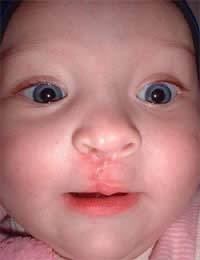Treating Cleft Lip and Palate

Cleft lip and palate is a birth defect that is usually diagnosed at birth. It affects the infant's upper lip and also the roof of the mouth. While there are varying degrees of it, treating cleft lip and palate is important to ensure the child can have normal speech, feeding and appearance.
What Causes Cleft Lip and Palate?
There are actually a number of causes of cleft lip and palate. It could be a genetic deformity passed down through the parents of the child. Or, certain drugs, viruses and other kinds of exposure during a woman's pregnancy can cause cleft lip and palate. Sometimes, cleft lip and palate doesn't occur alone; instead, other birth defects are present.What Are the Effects?
Sadly, the effects of cleft lip and palate can be severe. In more minor cases it could be a small notch seen on the lip. But in severe cases, it could be a significant groove that travels the full length of the mouth and reaches the nose.Those who suffer from cleft lip and palate will usually have their appearance affected and they can also have difficulties with eating and speaking. Ear infections are another problem associated with cleft lip and palate. A child could have a cleft lip, a cleft palate or both.
With a cleft lip, it ranges from a little notch in the lip to a full split to the nose base. A cleft palate could occur on only one side of the roof of the mouth or both and can extend the full length of the roof of the mouth. Other symptoms and issues relating to a cleft lip and palate include:
- Distorted nose structure
- Poorly aligned teeth
- Feeding problems that can lead to malnutrition and insufficient growth
- Problems with speech
- Increased dental caries
- Poor hearing
Diagnosing Cleft Lip and Palate
The diagnosis is usually done at birth through a physical examination. Surgery typically happens when the baby is between six weeks and nine months old to close the cleft lip and cleft palate. This way, it is remedied before a child begins to talk and could have their speech affected by the defect. Sometimes, more than one surgery is needed and a child could need extra support from a physician and orthodontist as they grow up.Prognosis for Children
Fortunately, most children who receive treatment can expect to have a normal appearance and normal feeding and speech. There has been some attention to this problem in third world and developing countries where infants do not have access to the surgery needed to repair cleft lip and palate. Charity organisations and dental surgeons have travelled to these countries to provide the care needed free of charge but there are still many children who do not receive this relatively straightforward treatment due to limited access to medical facilities and lack of funds.A Healthy Future
When a child is diagnosed with cleft lip and palate, it can be a devastating feeling for a parent. Modern advances in treatment and surgery, however, mean that the vast majority of children who receive surgery in a timely fashion will not suffer any long-term ill effects from the birth defect. These children can expect to live normal, healthy lives.- Can You Respond to a Dental Emergency?
- How Tongue Piercings Cause Tooth Gaps
- Night-time Eating and Tooth Loss
- Effects of Tooth Loss
- Dental Health Around the World
- Thumb Sucking and Your Child's Teeth
- Where Are Your Dental Crowns Made?
- What Can Go Wrong With Tooth Whitening
- What Diabetics Should Know About Teeth
- How to Avoid Bad Cosmetic Dentistry
- How Illegal Drug Use Affects Your Teeth
- Prescription Drugs and Dental Problems
- Oral Problems from Tongue and Lip Piercings
- Smoking and Dental Damage


Re: Dental Repairs - What is the General Expiry?
I am looking for re root canal treatment with ozone therapy, but unable to find one in the Cambridgeshire…
Re: Ozone Dental Therapy
Any good dentist that offer ozone therapy preferably in the west midlands or surrounding areas?
Re: Ozone Dental Therapy
Hello Andie I had this problem with my gums I had deep pockets . Brehens practice has be been a God sent , they do laser and do ask for…
Re: Ozone Dental Therapy
Hi I am looking for an Ozone dentist in the Newcastle upon Tyne area if anyone can help?
Re: Ozone Dental Therapy
Hi, I'm looking for a dentist in Cambridge, UK, that uses ozone therapy in their practice, can you help please, as an internet search has…
Re: Ozone Dental Therapy
Hello, how can I find a list of dentists in Surrey and SW London who are offering ideally both NHS dentistry plus Ozone Treatment? Any help…
Re: Ozone Dental Therapy
Lot’s of people asking the same question. Where can you find a dentist using Ozone treatment. Searched online and it seems London and the…
Re: Ozone Dental Therapy
Hello, i have had root canals and also still suffer from advanced periodontal disease Is there a list of dentists in London or Tgere about…
Re: Ozone Dental Therapy
Hi Since i had root canal done has caused me lot of doenside on my health evdn though i look after myself and diet. Recently i have had lump…
Re: Ozone Dental Therapy
Like Ann, I have also read the What Doctors Don't Tell You article on Ozone dental treatment and would like to find a dentist in the London…